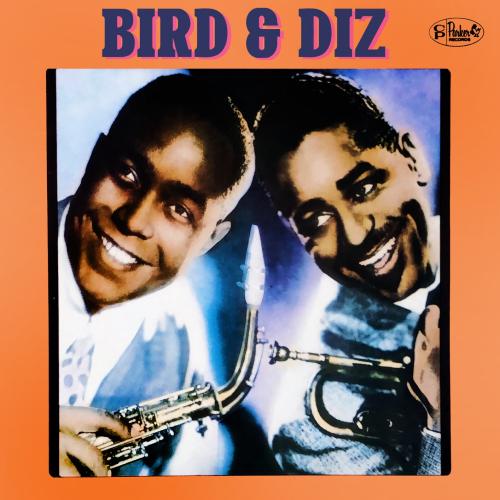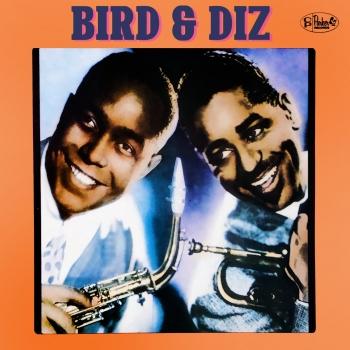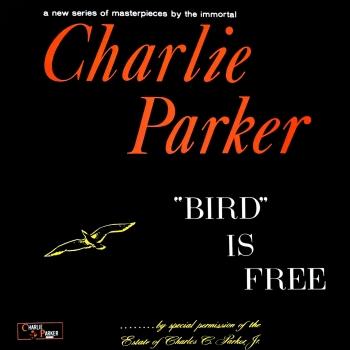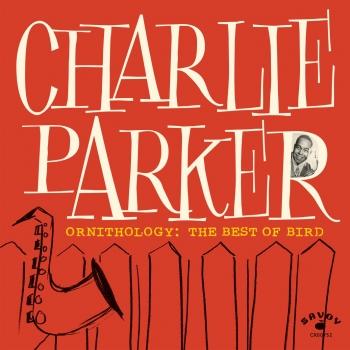
Bird & Diz (Remastered) Charlie Parker
Album Info
Album Veröffentlichung:
1951
HRA-Veröffentlichung:
20.01.2023
Das Album enthält Albumcover
- 1 Salt Peanuts 03:09
- 2 Shaw Nuff 02:57
- 3 Hot House 03:06
- 4 Groovin' High 04:55
- 5 Night In Tunisia 04:08
- 6 Salt Peanuts (Version 2) 03:07
- 7 Groovin' High (Version 2) 05:38
- 8 Introduction 01:48
- 9 Blue N' Boogie 07:17
- 10 Anthropology 06:11
- 11 Round Midnight 03:56
- 12 Night In Tunisia (Version 2) 04:59
- 13 Jumpin' With Symphony Sid 00:42
Info zu Bird & Diz (Remastered)
This 1952 collection is one of bebop's key artefacts and also represents two milestones: the only and only time that pianist Thelonious Monk recorded with the dynamic duo, and the last time Gillespie and Parker appeared together in the studio. It also features the red-hot rhythm section of bassist Curly Stewart and drummer Buddy Rich.
By any yardstick, alto saxophonist Charlie Parker and trumpeter Dizzy Gillespie were musical innovators. The harmonic and rhythmic revolution known as bebop in which they played major roles succeeded the big-band swing era of the Thirties and Forties and is considered the first kind of modern jazz.
"This collection of 78 rpm singles, all recorded on June 6, 1950, was released in 1956. Several things distinguish this from numerous other quintet recordings featuring these two bebop pioneers. It was recorded during the period that Parker was working under the aegis of producer Norman Granz, whose preference for large and unusual ensembles was notorious. The end result in this case is a date that sounds very much like those that Parker and Gillespie recorded for Savoy and Dial, except with top-of-the-line production quality. Even more interesting, though, is Parker's choice of Thelonious Monk as pianist. Unfortunately, Monk is buried in the mix and gets very little solo space, so his highly idiosyncratic genius doesn't get much exposure here. Still, this is an outstanding album -- there are fine versions of Parker standards like "Leap Frog," "Mohawk," and "Relaxin' with Lee," as well as a burning performance of "Bloomdido" and twjo interesting (if not entirely thrilling) renditions of the chestnut "My Melancholy Baby." (AMG)
Charlie Parker, alto saxophone
Dizzy Gillespie, trumpet
Thelonious Monk, piano
Curley Russell, bass
Buddy Rich, drums
Digitally remastered
Charlie Parker
The only child of Charles and Addie Parker, Charlie Parker was one of the most important and influential saxophonists and jazz players of the 1940’s.
When Parker was still a child, his family moved to Kansas City, Missouri, where jazz, blues and gospel music were flourishing. His first contact with music came from school, where he played baritone horn with the school’s band. When he was 15, he showed a great interest in music and a love for the alto saxophone. Soon, Parker was playing with local bands until 1935, when he left school to pursue a music career.
From 1935 to 1939, Parker worked in Kansas City with several local jazz and blues bands from which he developed his art. In 1939, Parker visited New York for the first time, and he stayed for nearly a year working as a professional musician and often participating in jam sessions. The New York atmosphere greatly influenced Parker's musical style.
In 1938, Parker joined the band of pianist Jay McShann, with whom he toured around Southwest Chicago and New York. A year later, Parker traveled to Chicago and was a regular performer at a club on 55th street. Parker soon moved to New York. He washed dishes at a local food place where he met guitarist Biddy Fleet, the man who taught him about instrumental harmony. Shortly afterwards, Parker returned to Kansas City to attend his father’s funeral. Once there, he joined Harlan Leonard’s Rockets and stayed for five months. In 1939, Yardbird rejoined McShann and was placed in charge of the reed section. Then, in 1940, Parker made his first recording with the McShann orchestra.
During the four years that Parker stayed with McShann's band, he got the opportunity to perform solo in several of their recordings, such as Hootie Blues, Sepian Bounce, and the 1941 hit Confessing the Blues. In 1942, while on tour with McShann, Parker performed in jam sessions at Monroe’s and Minton’s Playhouse in Harlem. There he caught the attention of up-and-coming jazz artists like Dizzy Gillespie and Thelonious Monk. Later that year, Parker broke with McShann and joined Earl Hines for eight months.
The year 1945 was extremely important for Parker. During that time he led his own group in New York and also worked with Gillespie in several ensembles. In December, Parker and Gillespie took their music to Hollywood on a six-week nightclub tour. Parker continued to perform in Los Angeles until June 1946, when he suffered a nervous breakdown and was confined at a state hospital. After his release in January 1947, Parker returned to New York and formed a quintet that performed some of his most famous tunes.
From 1947 to 1951, Parker worked in a number of nightclubs, radio studios, and other venues performing solo or with the accompaniment of other musicians. During this time, he visited Europe where he was cheered by devoted fans and did numerous recordings. March 5, 1955, was Parker’s last public engagement at Birdland, a nightclub in New York that was named in his honor. He died a week later in a friend’s apartment.
Charles 'Yardbird' Parker was an amazing saxophonist who gained wide recognition for his brilliant solos and innovative improvisations. He was, without a doubt, one of the most influential and talented musicians in jazz history.
Dieses Album enthält kein Booklet












